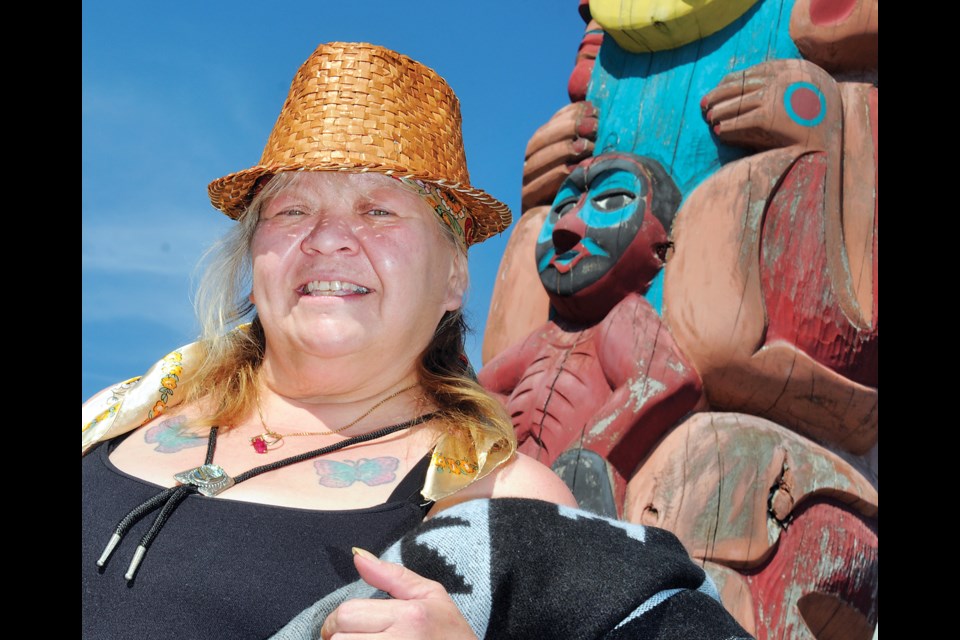As Truth and Reconciliation Day nears, those in North Vancouver and beyond will be looking for ways to better educate themselves on and engage with Indigenous culture, history and traditions. For some that might mean visiting the library and making use of their vast resources, for others it might mean taking a quiet moment to reflect.
Ask the Indigenous community themselves, however, and they will tell you that engaging with art, in all its forms, is the one-stop-shop for education, reflection, and reconciliation.
“Artworks are holders of knowledge, and our weavers, our artists, our painters and carvers, are therefore important knowledge holders,” said Tseil-Waututh artist and weaver Angela George.
Embedded within artworks are the tales and traditions that have been passed down from generation to generation, said George. Artwork is storytelling, and storytelling has always been an incredibly important part of Coast Salish culture.
“These artists have that role and responsibility to uphold the authentic knowledge of the people they represent and the communities they represent,” she said.
“We’re reinstating our oral traditions, and artwork is bringing that out. It’s showing the ancient trails to the places where we gathered medicine, it shows our connection to the land or connection to the water and says, without words, how and why that is important.”
George’s mural at The Shipyards, made in collaboration with Musqueam weaver and designer Debra Sparrow and Squamish (Sḵwx̱wú7mesh) weaver Chief Janice George, is an example of this. The piece, part of a wider Blanketing the City series, tells the story of the rescue efforts carried out by Indigenous first responders in the Great Vancouver Fire of 1886.
George’s visual stories and those of her contemporaries are becoming more prominent as the city works to implement more Indigenous public art.
Since January this year First Nations art has welcomed commuters to the TransLink SeaBus terminals, while two new sculptures at West Vancouver’s Park Royal shopping centre, by two Sḵwx̱wú7mesh Úxwumixw (Squamish Nation) artists, join the ever-growing collection of public art on the North Shore.
Candy Thomas, an artist from the Tsleil-Waututh Nation, said the works are a visual reminder of the city’s Tsleil-Waututh, Squamish and Musqueam history, each a preservation of Indigenous culture.
“Having these works out in public makes everybody feel good, it makes them feel proud. It makes them feel like they actually belong here now,” she said.
In other cases artwork can help shed light on Indigenous issues. Thomas is behind the large-scale mural artwork in Metro Vancouver’s sθәqәlxenәm ts’exwts’áxwi7 Rainbow Park, a piece designed to honour and raise awareness for the Missing and Murdered Indigenous Women.
“Artwork in this case spreads awareness, and also helps those who have lost their loved ones to heal,” she said.
“It’s not just a painting, this isn’t just art for art’s sake. It has more meaning than that because there’s the connection to our land, and our prayers and our thoughts, and our families. Knowing where we come from and the things we’re all going through, and being able to share that with everybody, is really important.”
George said there are multiple ways to engage with Indigenous art this Truth and Reconciliation Day. If not via giving more attention and thought to the public pieces scattered throughout the city, than by attending an exhibit, perusing online, or contacting the artists themselves.
“Artwork will always be relevant, because it’s holding knowledge and it’s sharing knowledge, but in a way that the viewer is going to interpret it and see it,” she said.
“I think it’s really important to be respectful of the ancestors of the land, and to learn from the genuine knowledge holders that are there. This is a narrative that needs to be told by them.”
Mina Kerr-Lazenby is the North Shore News’ Indigenous and civic affairs reporter. This reporting beat is made possible by the Local Journalism Initiative.




